Abstract
We obtained human T-cell hybridomas that are specific for bee venom phospholipase A2 (PLA2) and constitutively secrete glycosylation inhibiting factor (GIF). Upon crosslinking of CD3, the hybridoma produced GIF having affinity for PLA2. When affinity-purified PLA2-binding GIF was used as an immunogen, monoclonal antibodies specific for the antigen-binding GIF were obtained. Monoclonal antibody 110BH3 bound the antigen-binding GIF but failed to bind the 13-kDa nonspecific GIF, as determined by both bioassay and ELISA. In contrast, 388F1, a monoclonal antibody against nonspecific GIF, gave ELISA signals with both the nonspecific GIF and the antigen-binding GIF. Gel filtration of affinity-purified antigen-binding GIF revealed the presence of a 72- to 80-kDa protein which gave ELISA signals with both 110BH3 and 388F1 and contained GIF bioactivity. Upon reduction and alkylation, the antigen-binding GIF dissociated into a 62- to 64-kDa protein which gave positive ELISA with antibody 110BH3 but no signal with antibody 388F1, and a 15-kDa protein, which gave ELISA signal with the 388F1 but not with 110BH3. Immunoblotting of a PLA2-binding GIF preparation revealed that under reducing conditions, the antigen-binding GIF dissociated a 13-kDa peptide which reacted with polyclonal antibodies against recombinant GIF. The results indicate that the 13-kDa nonspecific GIF is a subunit of antigen-binding GIF. The PLA2-binding GIF has affinity for an epitope, representing amino acid residues 19-28 in PLA2 which appears to be an external structure in the antigen.
Full text
PDF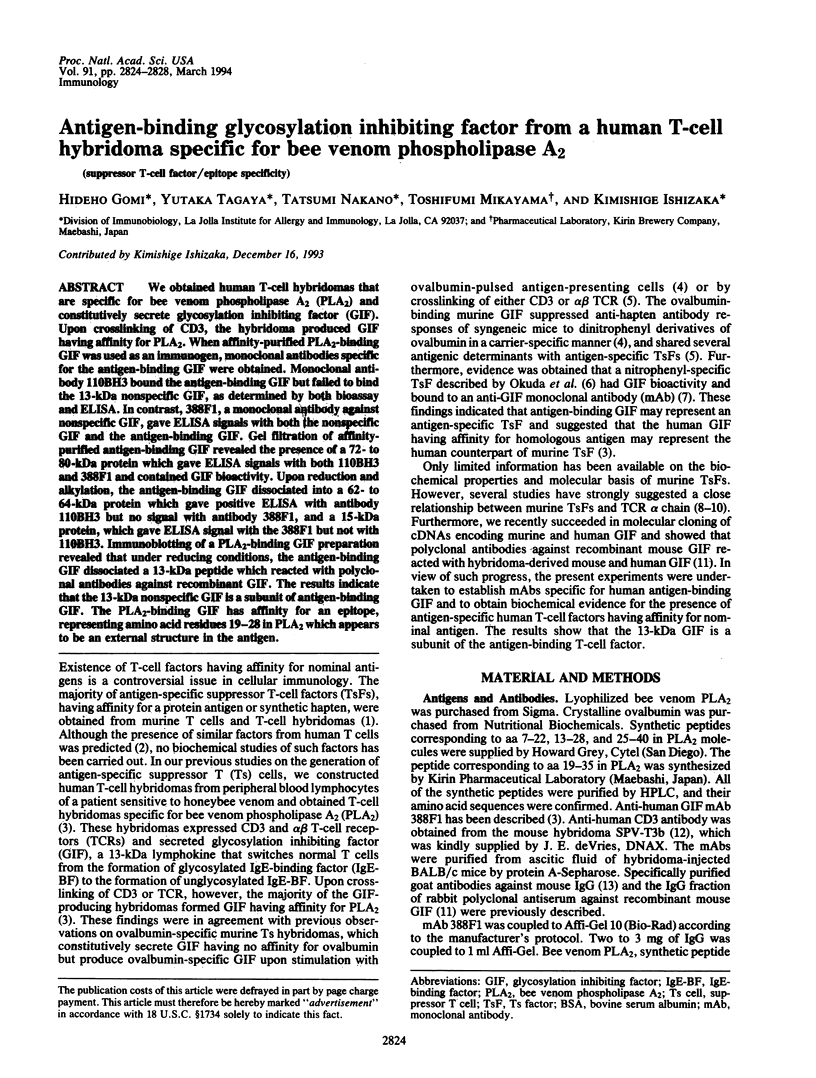
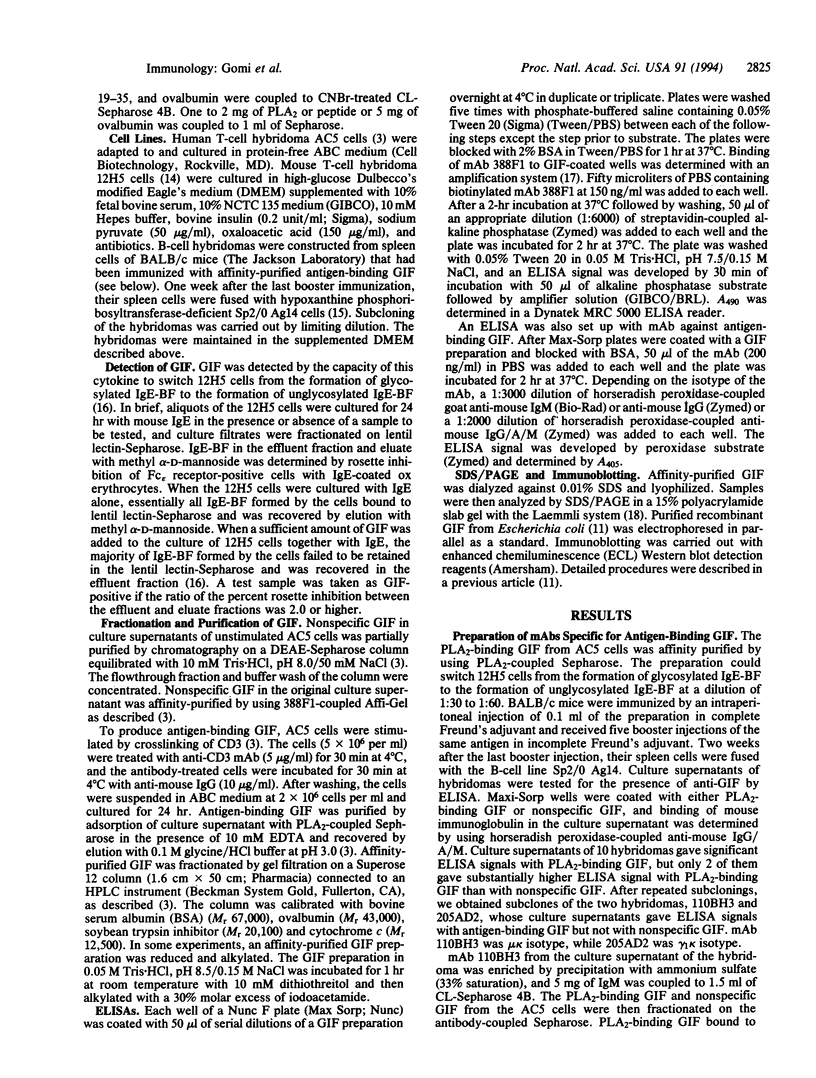
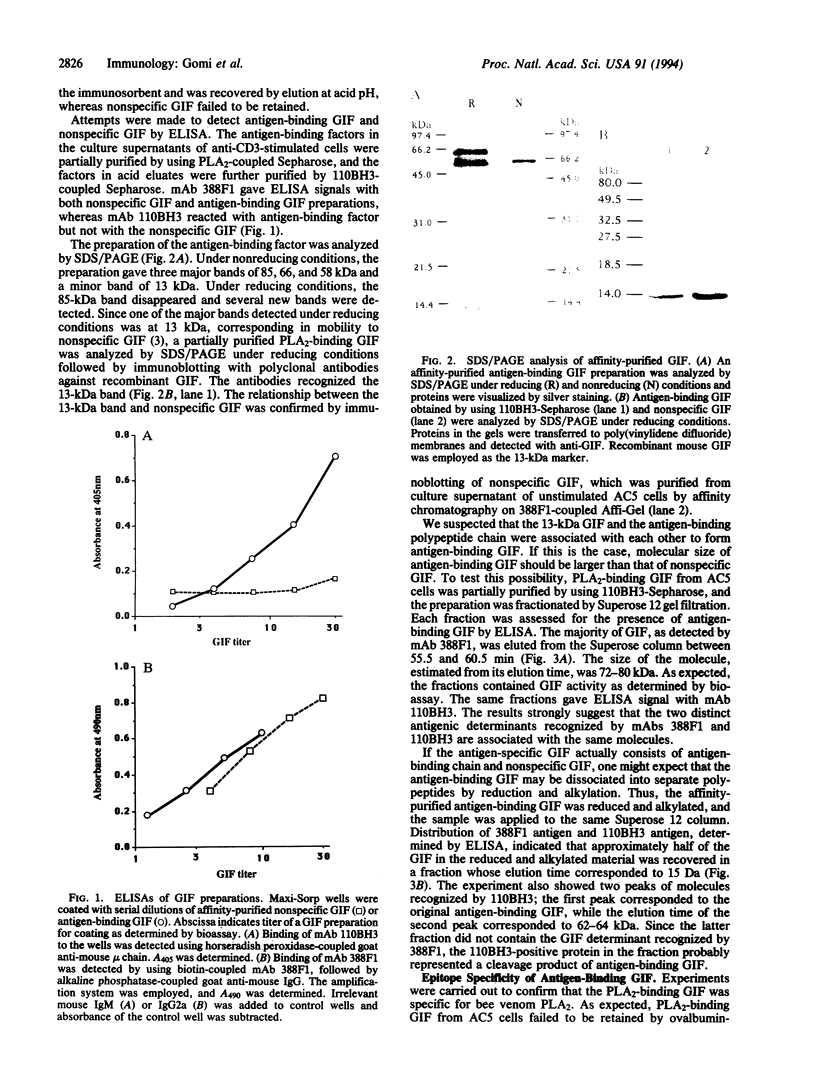
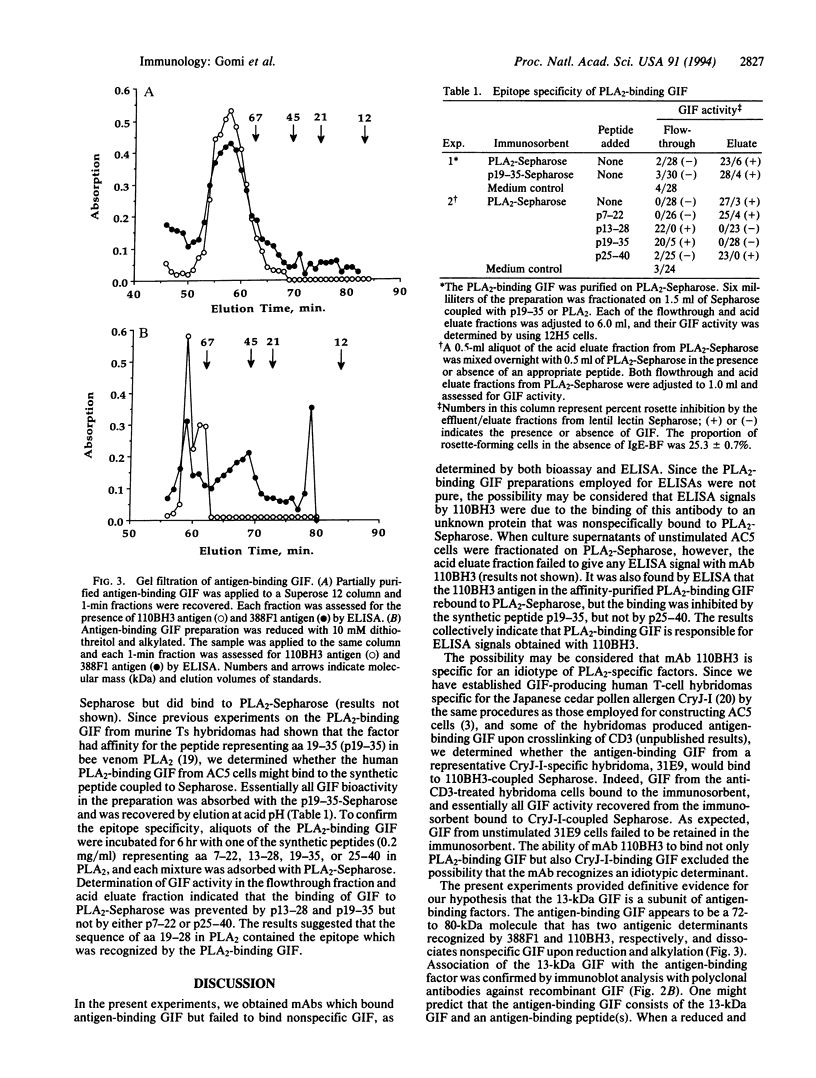
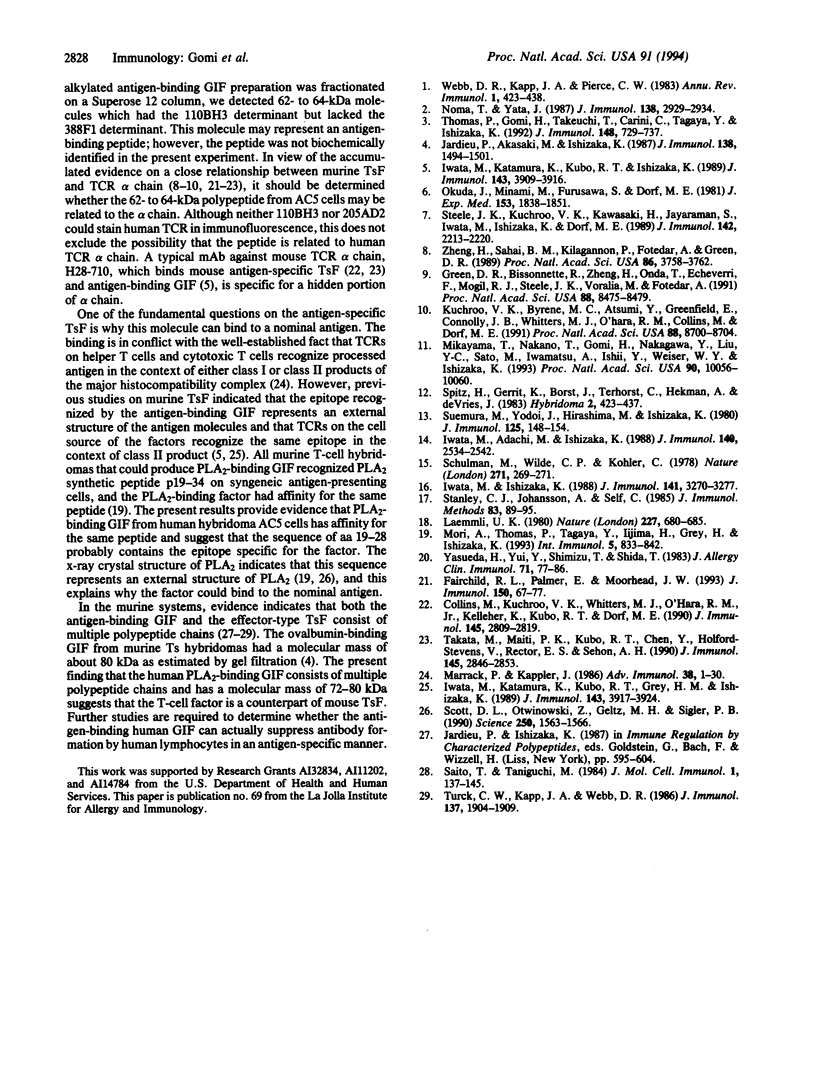
Images in this article
Selected References
These references are in PubMed. This may not be the complete list of references from this article.
- Collins M., Kuchroo V. K., Whitters M. J., O'Hara R. M., Jr, Kelleher K., Kubo R. T., Dorf M. E. Expression of functional alpha beta T cell receptor gene rearrangements in suppressor T cell hybridomas correlates with antigen binding, but not with suppressor cell function. J Immunol. 1990 Nov 1;145(9):2809–2819. [PubMed] [Google Scholar]
- Fairchild R. L., Palmer E., Moorhead J. W. Production of DNP-specific/class I MHC-restricted suppressor molecules is linked to the expression of T cell receptor alpha- and beta-chain genes. J Immunol. 1993 Jan 1;150(1):67–77. [PubMed] [Google Scholar]
- Green D. R., Bissonnette R., Zheng H. G., Onda T., Echeverri F., Mogil R. J., Steele J. K., Voralia M., Fotedar A. Immunoregulatory activity of the T-cell receptor alpha chain demonstrated by retroviral gene transfer. Proc Natl Acad Sci U S A. 1991 Oct 1;88(19):8475–8479. doi: 10.1073/pnas.88.19.8475. [DOI] [PMC free article] [PubMed] [Google Scholar]
- Iwata M., Adachi M., Ishizaka K. Antigen-specific T cells that form IgE-potentiating factor, IgG-potentiating factor, and antigen-specific glycosylation-enhancing factor on antigenic stimulation. J Immunol. 1988 Apr 15;140(8):2534–2542. [PubMed] [Google Scholar]
- Iwata M., Ishizaka K. Construction of antigen-specific suppressor T cell hybridomas from spleen cells of mice primed for the persistent IgE antibody formation. J Immunol. 1988 Nov 15;141(10):3270–3277. [PubMed] [Google Scholar]
- Iwata M., Katamura K., Kubo R. T., Grey H. M., Ishizaka K. Relationship between T cell receptors and antigen-binding factors. II. Common antigenic determinants and epitope recognition shared by T cell receptors and antigen-binding factors. J Immunol. 1989 Dec 15;143(12):3917–3924. [PubMed] [Google Scholar]
- Iwata M., Katamura K., Kubo R. T., Ishizaka K. Relationship between T cell receptors and antigen-binding factors. I. Specificity of functional T cell receptors on mouse T cell hybridomas that produce antigen-binding T cell factors. J Immunol. 1989 Dec 15;143(12):3909–3916. [PubMed] [Google Scholar]
- Jardieu P., Akasaki M., Ishizaka K. Carrier-specific suppression of antibody responses by antigen-specific glycosylation-inhibiting factors. J Immunol. 1987 Mar 1;138(5):1494–1501. [PubMed] [Google Scholar]
- Kuchroo V. K., Byrne M. C., Atsumi Y., Greenfield E., Connolly J. B., Whitters M. J., O'Hara R. M., Jr, Collins M., Dorf M. E. T-cell receptor alpha chain plays a critical role in antigen-specific suppressor cell function. Proc Natl Acad Sci U S A. 1991 Oct 1;88(19):8700–8704. doi: 10.1073/pnas.88.19.8700. [DOI] [PMC free article] [PubMed] [Google Scholar]
- Laemmli U. K. Cleavage of structural proteins during the assembly of the head of bacteriophage T4. Nature. 1970 Aug 15;227(5259):680–685. doi: 10.1038/227680a0. [DOI] [PubMed] [Google Scholar]
- Marrack P., Kappler J. The antigen-specific, major histocompatibility complex-restricted receptor on T cells. Adv Immunol. 1986;38:1–30. doi: 10.1016/s0065-2776(08)60005-x. [DOI] [PubMed] [Google Scholar]
- Mikayama T., Nakano T., Gomi H., Nakagawa Y., Liu Y. C., Sato M., Iwamatsu A., Ishii Y., Weiser W. Y., Ishizaka K. Molecular cloning and functional expression of a cDNA encoding glycosylation-inhibiting factor. Proc Natl Acad Sci U S A. 1993 Nov 1;90(21):10056–10060. doi: 10.1073/pnas.90.21.10056. [DOI] [PMC free article] [PubMed] [Google Scholar]
- Mori A., Thomas P., Tagaya Y., Iijima H., Grey H., Ishizaka K. Epitope specificity of bee venom phospholipase A2-specific suppressor T cells which produce antigen-binding glycosylation inhibiting factor. Int Immunol. 1993 Aug;5(8):833–842. doi: 10.1093/intimm/5.8.833. [DOI] [PubMed] [Google Scholar]
- Noma T., Yata J. Establishment of a human T cell hybridoma cell line producing suppressor factor specific for anti-thyroglobulin antibody production. J Immunol. 1987 May 1;138(9):2929–2934. [PubMed] [Google Scholar]
- Okuda K., Minami M., Furusawa M., Dorf M. E. Analysis of T cell hybridomas. II. Comparisons among three distinct types of monoclonal suppressor factors. J Exp Med. 1981 Dec 1;154(6):1838–1851. doi: 10.1084/jem.154.6.1838. [DOI] [PMC free article] [PubMed] [Google Scholar]
- Saito T., Taniguchi M. Chemical features of an antigen-specific suppressor T cell factor composed of two polypeptide chains. J Mol Cell Immunol. 1984;1(3):137–145. [PubMed] [Google Scholar]
- Scott D. L., Otwinowski Z., Gelb M. H., Sigler P. B. Crystal structure of bee-venom phospholipase A2 in a complex with a transition-state analogue. Science. 1990 Dec 14;250(4987):1563–1566. doi: 10.1126/science.2274788. [DOI] [PubMed] [Google Scholar]
- Shulman M., Wilde C. D., Köhler G. A better cell line for making hybridomas secreting specific antibodies. Nature. 1978 Nov 16;276(5685):269–270. doi: 10.1038/276269a0. [DOI] [PubMed] [Google Scholar]
- Spits H., Keizer G., Borst J., Terhorst C., Hekman A., de Vries J. E. Characterization of monoclonal antibodies against cell surface molecules associated with cytotoxic activity of natural and activated killer cells and cloned CTL lines. Hybridoma. 1983;2(4):423–437. doi: 10.1089/hyb.1983.2.423. [DOI] [PubMed] [Google Scholar]
- Stanley C. J., Johannsson A., Self C. H. Enzyme amplification can enhance both the speed and the sensitivity of immunoassays. J Immunol Methods. 1985 Oct 24;83(1):89–95. doi: 10.1016/0022-1759(85)90061-4. [DOI] [PubMed] [Google Scholar]
- Steele J. K., Kuchroo V. K., Kawasaki H., Jayaraman S., Iwata M., Ishizaka K., Dorf M. E. A monoclonal antibody raised to lipomodulin recognizes T suppressor factors in two independent hapten-specific suppressor networks. J Immunol. 1989 Apr 1;142(7):2213–2220. [PubMed] [Google Scholar]
- Suemura M., Yodoi J., Hirashima M., Ishizaka K. Regulatory role of IgE-binding factors from rat T lymphocytes. I. Mechanism of enhancement of IgE response by IgE-potentiating factor. J Immunol. 1980 Jul;125(1):148–154. [PubMed] [Google Scholar]
- Takata M., Maiti P. K., Kubo R. T., Chen Y. H., Holford-Strevens V., Rector E. S., Sehon A. H. Cloned suppressor T cells derived from mice tolerized with conjugates of antigen and monomethoxypolyethylene glycol. Relationship between monoclonal T suppressor factor and the T cell receptor. J Immunol. 1990 Nov 1;145(9):2846–2853. [PubMed] [Google Scholar]
- Thomas P., Gomi H., Takeuchi T., Carini C., Tagaya Y., Ishizaka K. Glycosylation-inhibiting factor from human T cell hybridomas constructed from peripheral blood lymphocytes of a bee venom-sensitive allergic patient. J Immunol. 1992 Feb 1;148(3):729–737. [PubMed] [Google Scholar]
- Turck C. W., Kapp J. A., Webb D. R. Structural analyses of a monoclonal heterodimeric suppressor factor specific for L-glutamic acid60-L-alanine30-L-tyrosine10. J Immunol. 1986 Sep 15;137(6):1904–1909. [PubMed] [Google Scholar]
- Webb D. R., Kapp J. A., Pierce C. W. The biochemistry of antigen-specific T-cell factors. Annu Rev Immunol. 1983;1:423–438. doi: 10.1146/annurev.iy.01.040183.002231. [DOI] [PubMed] [Google Scholar]
- Yasueda H., Yui Y., Shimizu T., Shida T. Isolation and partial characterization of the major allergen from Japanese cedar (Cryptomeria japonica) pollen. J Allergy Clin Immunol. 1983 Jan;71(1 Pt 1):77–86. doi: 10.1016/0091-6749(83)90550-x. [DOI] [PubMed] [Google Scholar]
- Zheng H., Sahai B. M., Kilgannon P., Fotedar A., Green D. R. Specific inhibition of cell-surface T-cell receptor expression by antisense oligodeoxynucleotides and its effect on the production of an antigen-specific regulatory T-cell factor. Proc Natl Acad Sci U S A. 1989 May;86(10):3758–3762. doi: 10.1073/pnas.86.10.3758. [DOI] [PMC free article] [PubMed] [Google Scholar]



